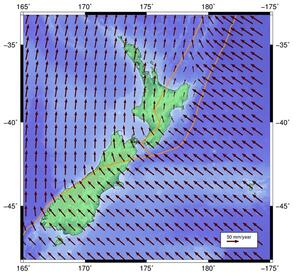Geodetic datums can be classified into three categories:
- Static – the coordinates of a point remain fixed at the time of their initial survey.
In a static datum, coordinates of a mark do not change unless a new survey (remeasurement or recalculation) of the mark takes place. Examples include: - Dynamic – the coordinates of a point are regularly updated to account for deformation and tectonic motion.
In a dynamic datum, coordinates of a mark regularly change to track the motion of tectonic plates or other regional deformation. Examples include: - Semi-Dynamic – a hybrid of static and dynamic geodetic datums, with the coordinates of a mark determined by a local or regional framework.
In the case of New Zealand Geodetic Datum 2000 (NZGD2000), coordinates of a mark appear static, as current horizontal coordinates are converted back to a reference date by modelling for the constant motion of the tectonic plates or other regional deformation.
New Zealand’s semi-dynamic datum
NZGD2000 is a semi-dynamic datum, with coordinates aligned to the International Terrestrial Reference Frame 1996 (ITRF96), at the reference date of 1 January 2000 (epoch 2000.0).
This means that NZGD2000 appears to provide constant (or unchanging) coordinates for positions, even though New Zealand is continuously moving and deforming due to processes caused by the Australian and Pacific tectonic plates. The datum itself moves with the plate motion by applying a horizontal deformation model. This means that NZGD2000 is a plate-fixed datum.
This diagram shows vectors of approximately 5cm a year (north-west for the Pacific Plate and north for the Australian Plate) superimposed over a map of New Zealand at its major fault lines. The impact of the model is easiest seen when looking at coordinates in New Zealand using a dynamic datum such as ITRF96. In these systems the coordinates of points are changing at around 5cm per year. In the example image below we see the Pacific Plate moving in a north-western direction and the Australian Plate moving in a northern direction.

Plate-fixed model showing the average plate tectonic movement in New Zealand relative to the International Terrestrial Reference Frame 1996 (ITRF96). This diagram shows vectors of approximately 5cm a year (north-west for the Pacific Plate and north for the Australian Plate) superimposed over a map of New Zealand.
Plate-fixed model showing the average plate tectonic movement in New Zealand relative to the International Terrestrial Reference Frame 1996 (ITRF96). This diagram shows vectors of approximately 5cm a year (north-west for the Pacific Plate and north for the Australian Plate) superimposed over a map of New Zealand
NZGD2000 coordinates are updated:
- when a new survey takes place
- when the National Geodetic Adjustment is updated
- when the deformation model is improved
- after a significant earthquake event has occurred (such as after Kaikoura 2016 - see Kaikoura earthquake coordinate update).
Four-dimensional datum transformations
The models that account for motion and deformation used in dynamic and semi-dynamic geodetic datum transformations are time dependent. This means that the amount of motion which has occurred is calculated based on the amount of time that has elapsed. As a result, dynamic and semi-dynamic datums can be considered 4-dimensional, as time (t) is included alongside latitude (Φ), longitude (λ), and ellipsoidal height (H).
Find out more about coordinate transformation
NZGD2000 is often considered to be aligned with ITRF96 datum and equivalent to WGS84 datum at the reference data of 1 January 2000. However, a difference of up to 5cm per year (or about 1.25m in 2025) is seen between NZGD2000 and these dynamic datums. NZGD2000 coordinates may also have been recalculated due to additional survey data or following a significant earthquake. Coordinates from time-dependent datums must be managed with care so that accuracy can be maintained.